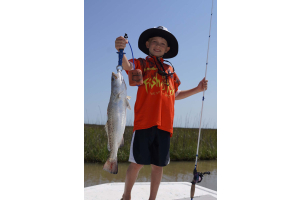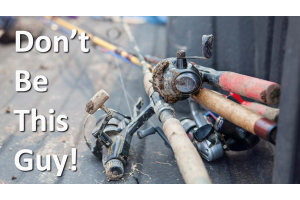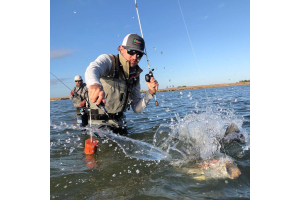Rod Care and Transportation: Essential Tips for Every Angler

Whether you're an experienced angler or just starting, taking good care of your fishing rods is essential. FishStix is here to share some valuable insights on maintaining your gear, no matter where you're casting your line.
The Importance of Rod Care
Before we dive into the nitty-gritty of rod maintenance, let's talk about why it's crucial. Your fishing rod isn't just a tool; it's your partner in reeling in those big catches. The modern fishing rod is the result of a significant advancements in material science, driven by a relentless quest for the right balance between sensitivity and strength. When mishandled, they are subject to tiny, often invisible nicks and bruises, creating areas of weakness. This can lead to unexpected – and unwelcome – snapping of the rod, even in situations that most might consider normal use.
Proper care not only extends its lifespan but also ensures peak performance every time you hit the water.
Keeping It Clean
After a satisfying day of fishing, your rod deserves some attention. Grab a bucket of warm, soapy water and a soft cloth, and let's start the cleaning process.
- Rinse Off: Begin by giving your rod a thorough rinse with fresh water. This helps remove any salt, sand, or debris that could lead to corrosion.
- Soap It Up: Add a small amount of mild dish soap to your bucket of warm water and gently wash your rod. Avoid using abrasive materials that could scratch the finish.
- Handle with Care: Pay extra attention to the handle and reel seat, as these areas can accumulate sweat and grime. Clean them thoroughly.
- Rinse Again: Make sure to rinse your rod completely to remove any soap residue, which can cause damage if left on the surface.
- Proper Drying: After washing, use a clean, soft cloth to pat your rod dry. Ensure it's completely dry before storing it.
Safely Transporting Your Rods
Now, let's discuss the safe transport of your fishing rods. We've all seen rods sticking out of vehicle windows, sticking out of PVC tubes, and strapped precariously to rooftops. Let's avoid those scenarios and keep your gear protected.
- In Your Boat: You’ve seen ‘em: The people who ride down the highway with their rods sticking up out of the rod holders in their boats. Don’t be one of those people. The weights and corks banging up against the rod blank in a 70 MPH wind damages the rod blank, causing weak spots where the rod is more likely to break.
- In Your Truck: It happens a lot. Somebody comes into our store with a rod that was broken or damaged because a cooler or some other heavy item slid into the rod in the bed of their truck. Or somebody tossed something into the bed of the truck, and it landed on the rod, breaking or damaging it. And consider all the dust and grit that gets into your reel when the rod is in the bed of your truck. The lesson: don’t transport rods in the bed of your truck. Keep them warm safe and protected inside the cab!
- Rod Tubes: For longer journeys or when flying with your gear, rod tubes are a solid choice. They offer excellent protection against rough handling.
- Rod Socks: Invest in rod socks or sleeves to shield your rods from scratches and minor impacts. They're an affordable way to add an extra layer of protection.
- Inside the Vehicle: If you're carrying your rods inside your vehicle, make sure they're laid flat and securely fastened. Avoid allowing them to bounce around or become entangled.
- Tailgate Extenders: Pickup truck owners can use tailgate extenders to provide additional support for their rods when transporting them horizontally.
Common Rod Pitfalls to Avoid
To wrap things up, let's go over some common mistakes anglers make when it comes to their fishing rods:
- The best tip: Don’t reel your lure, swivel, or hook into the rod tip. Over time this damages the tip, requiring tip replacement. While tip replacement is an inexpensive, outpatient procedure, it is a hassle, and it’s the last thing you want to deal with when you’re on the water. There’s a better way: Secure the lure in the hook-keeper guide and wrap it with a piece of reusable Gear Tie.
- Handle it wisely: Don’t ever grab a rod that is under a load at any point other than the handle! Rods are amazingly strong when used properly. They are designed to bend in a smooth arc from butt to tip. As tempting and logical as it may seem, grabbing the rod above the handle while landing a fish or freeing a snagged lure is a terrible idea and can lead to a snapped rod.
- The weighting shouldn’t be the hardest part. It’s printed right there on your rod’s butt section: the manufacturer’s recommended lure weight. Exceeding these recommendations can greatly increase the risk of the rod failing when making a cast.
- Neglecting Reel Maintenance: Don't forget about your reel; it's just as vital as your rod. Keep it clean, lubricated, and free of sand and debris.
- High-Sticking: Be cautious when lifting your rod too high during a fight with a fish. Excessive strain can lead to damage.
- Saltwater Neglect: If you fish in saltwater, always rinse your gear thoroughly after each outing. Salt can be corrosive if left unchecked.
- Avoid Rough Handling: Steer clear of knocking your rod against hard surfaces like rocks or boat gunwales. Such impacts can lead to breakage.
The Final Cast
No matter where you're casting your line in the USA, taking good care of your fishing rods is essential for a successful and enjoyable fishing experience. Whether you're a seasoned angler or just starting out, treating your gear with care will pay off in the long run.
So, fellow anglers, follow these tips to ensure your fishing rods remain in top-notch condition. Whether you're chasing redfish in Texas or angling for trout in Montana, well-maintained gear is your ticket to unforgettable fishing adventures. Now, go out there and make every cast count!







